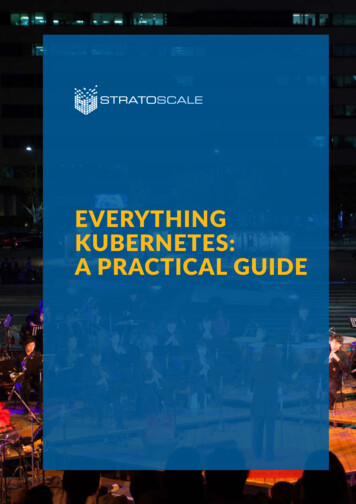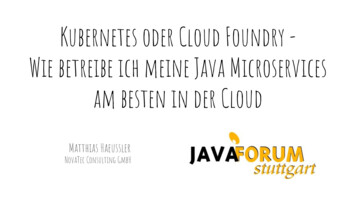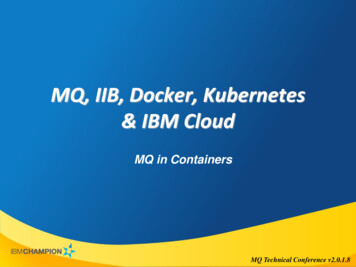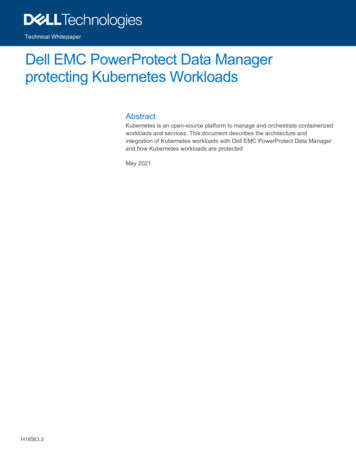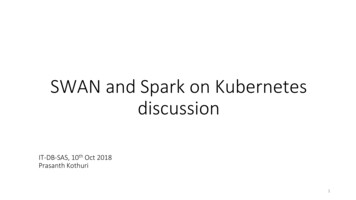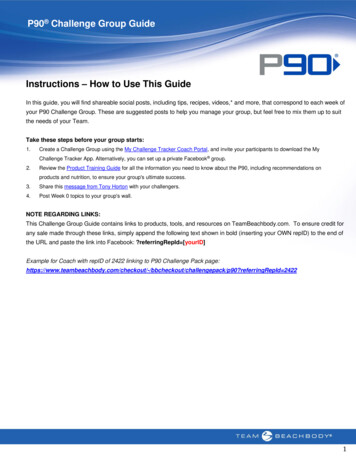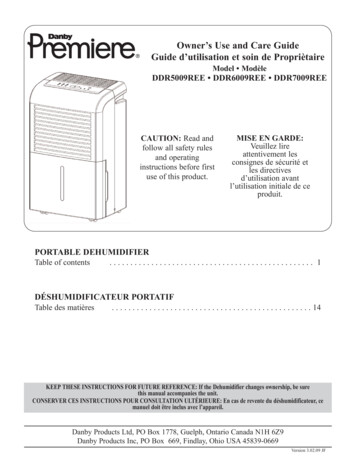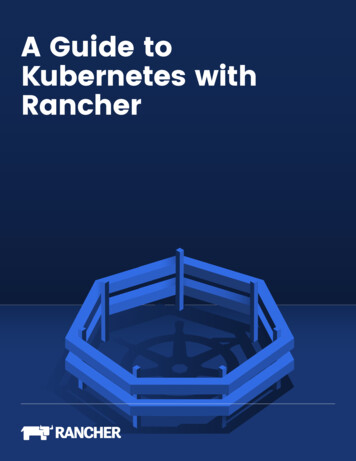
Transcription
A Guide toKubernetes withRancher
WRANGLING KUBERNETES WITH RANCHERTABLE OF CONTENTSTable of ContentsWrangling Kubernetes with Rancher. 1Introduction. 1Who is Rancher Labs?. 1Partnering with Rancher on Your Kubernetes Journey 2A Multi-Cluster Future for Cloud Applications.3Scenarios Where Rancher Can Lend a Hand.5Starting Your Kubernetes Journey. 6Rancher Resources for Getting Started.7JANUARY 2019TABLE OF CONTENTS
A GUIDE TO KUBERNETES WITH RANCHERWrangling Kubernetes with RancherINTRODUCTIONCongratulations on starting your journey with Linux containers! Your team has astutely chosen the development and deploymentframework that provides application portability, agility, and scalability. Installing Docker was the start of your containerjourney. Now, you’re ready to deploy your container-based application at scale with Kubernetes. At this point you’re faced with abewildering array of software vendors, cloud providers, and open source projects that all promise painless, successful Kubernetesdeployments. How do you decide where to go from here?Rancher will help you wade through that confusion.Just as Docker is the best first step in developing container-based applications, Rancher Labs is your logical partner in deployingat scale. While you might not need planetary-scale deployment today, you and your DevOps team can rest assured that when youhit that milestone, Rancher has the capabilities to handle the largest clusters across all flavors of Kubernetes: from on-premises tohybrid and from a single public cloud to multi-cloud deployments within independent providers.More importantly, as your partner on this journey, Rancher Labs holds true to the open source roots of containers. We don’tsubscribe to the dual-class freemium model. Rancher is truly open source, with full capabilities available to everyone. OnlyRancher provides a residue-free uninstall that leaves your existing Kubernetes infrastructure up and running with no ghosts in themachines. We’ll be there for you when you need us but can disappear if you decide you don’t. When you change your mind, a simplereinstall gets us back in, seamlessly supporting you as if we never left.This paper introduces Rancher’s philosophy and capabilities and explains how Rancher partners with thousands of users to providethem with the best container management experience. In it we share more about the journey to large-scale container deploymentand the key requirements for multi-cluster management. At the end we wrap up with concrete steps on how to get started usingKubernetes with Rancher.WHO IS RANCHER LABS?Rancher Labs was founded in 2014 toprovide the tools needed to take fulladvantage of container technology. Webelieve that Kubernetes will enable a newWorkload ManagementUser Interface App Catalog CI/CD Monitoring Loggingera of application portability. Our flagshipproduct, Rancher, is a complete containermanagement platform that provides aneasy on-ramp to working with all types ofKubernetes installations.Unified Cluster ManagementProvisioning Authentication RBAC Policy Capacity CostTo ensure success with Kubernetes,Rancher includes a rich set ofcapabilities. Knowing you’ll need themsooner or later, we’ve incorporated intoour platform the features most requestedJANUARY 2019Rancher Kubernetes EnginevSphere Bare MetalEKSGKEAKS1
A GUIDE TO KUBERNETES WITH RANCHERby thousands of customers. Having these built-in saves you timeand money, avoiding the hundreds of hours needed to configure,integrate, troubleshoot, and maintain the multitude of opensource projects needed to provide comparable functionality.App CatalogRancher’s enterprise-friendly features include a built-inapplication catalog, integrated monitoring and logging, andCI/CDsuperior RBAC. Having these available from the beginning getsyou off to a great start as you scale your deployment.PARTNERING WITH RANCHER ONYOUR KUBERNETES JOURNEYWhen you and your team negotiate spinning up your first Dockercontainers, you’ll come to realize that running workloads onmultiple servers isn’t Docker’s strength. Instead, Kubernetes isMonitoring & LoggingAccess ControlOrchestration & SchedulingConfig DBthe best tool when it comes to container cluster management:it runs the right containers at the right time, scales them upSecrets & Securityand down according to load, deals with hardware or containerfailure, and manages networking and storage.Choosing Kubernetes for scaling your containerized applicationis the right call, but the last thing you want is your teamRegistryContainer Enginewasting time on dissecting the intricacies of the differentKubernetes hosting options. Ideally, you want to find a partnerNetwork & Storagewith expertise across all platform types who can guide you.This allows your DevOps and application development teamsCloud Integrationto focus on more pertinent questions and tasks that createvalue. For example, which features should be in this sprint?How should they architect the software to bring unique value?Which database technology should they choose for differentapplication components?On the subject of platform types, if you have yet to make a decision on where to run Kubernetes, there are three initial optionsbased on your business requirements:A. Deploy on a hosted Kubernetes provider like Google Kubernetes Engine (GKE), Amazon Elastic Container Servicefor Kubernetes (EKS) or Azure Kubernetes Service (AKS).B. Install, run, and manage Kubernetes on an IaaS platform such as Amazon EC2, Azure, Google Cloud orDigitalOcean.C. Install, run, and manage Kubernetes on infrastructure you own, either on bare metal or on a private cloud solutionlike VMware.The latter two options require installation and configuration of Kubernetes. You may have seen Google’s Kelsey Hightower explainthe steps involved in his well-known tutorial—Kubernetes, the Hard Way. If so, you have an appreciation of the difficulties involved.While there are scripts and automation tools like kops, kubo and kubespray, some are limited in their support of different platforms,and none provide post-installation cluster management. Rancher provides a streamlined installation that minimizes complexity,providing a consistent way to install Kubernetes on any platform. Plus, it provides cluster management, at scale.JANUARY 20192
A GUIDE TO KUBERNETES WITH RANCHEREven if you’re using a solution that delivers a pre-built Kubernetes cluster, there are significant benefits to using Rancher. Itintegrates seamlessly into the management infrastructure of GKE, EKS, and AKS and gives you full control of cloud resources.Instead of having to learn three different interfaces, Rancher provides a common and consistent view of each of these hostedservices with a single pane of glass for accessing and interacting with them.Rancher’s Breadth of Platform SupportAs your candidate partner in Kubernetes deployment, let’s look at Rancher’s capabilities across all the key types of container hosts.PlatformBare Metal ServersWhat Rancher ProvidesRancher provisions and installs Kubernetes on racks of bare metal servers anddelivers a scalable container infrastructure without the overhead of virtualization.Rancher integrates seamlessly with your VM infrastructure, running containersvSphere/ESXion top of VMs, allowing you to benefit from snapshots, DR, and other benefits youexpect from your VM infrastructure. In this environment, you can run container andnon-container workloads side by side.Rancher provisions compute instances, installs Kubernetes onto them, and thenEC2, Azure, GCE, Digital Oceanmanages the full lifecycle of all resources. This allows you to benefit from an IaaSplatform while running a Kubernetes-managed container cluster.Rancher provides full management of the cloud resources themselves, includingthe ability to spin resources up and down. However, instead of learning differentGKE, EKS, AKSinterfaces each time you switch clouds or managing accounts and access betweenthem, Rancher provides a common and consistent view of each of these hostedservices. It centralizes RBAC and keeps your clusters secure.For those who have already deployed Kubernetes, existing clusters can be folded into Rancher’s management framework. Forinstance, if your development team has a cluster running on GKE, you can install Rancher and import the existing GKE cluster.Likewise, moving from one provider to another is as easy as creating a new cluster at the new provider with Rancher and migratingworkloads from the existing cluster. Since all the configuration of resources, such as security, policies, etc., exist within Rancher,these resources can be easily spun up elsewhere and a simple DNS update completes the application migration.Rancher also provides the complete set of tools required to manage all aspects of the application lifecycle on the platform.Regardless of which Kubernetes cluster type Rancher manages, it can tie into in-house components like Microsoft’s ActiveDirectory, provide enterprise-level monitoring, visibility and troubleshooting, and integrate seamlessly with CI/CD pipelines.JANUARY 20193
A GUIDE TO KUBERNETES WITH RANCHERA MULTI-CLUSTER FUTURE FOR CLOUD APPLICATIONSSo far, we’ve only discussed single Kubernetes clusters. Enterprises who adopted Kubernetes early will likely find themselves stuckwith managing multiple clusters, one silo at a time. These unfortunate enterprises discover they can’t easily migrate applicationsacross different clouds to take advantage of lower costs or new capabilities. In addition, if one of their public cloud providers failsor an availability zone becomes crippled, they can’t easily instantiate their containerized application on another provider’s cloudwithout jumping through many hoops.Most DevOps teams would agree that the benefits of a true multi-cloud, multi-cluster platform are quite compelling. Fortunately,Rancher provides multi-cloud and multi-cluster Kubernetes management from a single console, all while maintaining the samedevelopment environment and workflow for the application development team. In addition, as an enterprise-grade solution,Rancher provides other capabilities: Agnosticism: a true multi-cluster system should be able to manage any Kubernetes-based platform in bothprivate and public clouds. Rancher integrates with a wide breadth of platforms and does so while providing theconsistency of a single front-end interface. Seamless hybrid cloud support: while many development teams favor the use of public cloud infrastructure torun their containers, enterprises in regulated industries or those that face data jurisdiction issues might needto depend on private clouds. Rancher supports public clouds but also excels at deploying natively on a privatecloud, either on bare metal or on an enterprise VM foundation like VMware’s vSphere. It also supports airgapinstallations and edge deployments. Centralized policies: a multi-cluster solution needs to allow for centralized configuration of policies that canbe pushed and enforced across each Kubernetes cluster. For example, a specific network policy that governsconnectivity between individual services in a three-tier web application can be created once on Rancher andpushed across AKS, EKS, and GKE without having to be reconfigured in each Kubernetes silo. Centralized RBAC and identity management: most enterprises have identity and roles stored within MicrosoftActive Directory (AD) and LDAP. Native Kubernetes is not particularly strong in its support of identity and roles.However, Rancher can integrate with AD, LDAP, SAML, OpenID, and other services and leverage those sameenterprise identities and roles for permission and access control across all clusters. Centralized visibility and troubleshooting: logging into each Kubernetes cluster to learn the status of the podsand to work through alerts silo-by-silo is inefficient and likely to result in overlooking potential infrastructureissues. A multi-cluster-aware solution like Rancher can unify visibility across all clusters and present themthrough a unified interface.These features are central to Rancher’s value to the enterprise, but Rancher’s capabilities extend much further than this. Rancheralso includes public and private application catalogs with Helm support, as well as integrated Prometheus monitoring with alerts,full audit logging, and log shipping to a variety of endpoints.JANUARY 20194
A GUIDE TO KUBERNETES WITH RANCHERSCENARIOS WHERE RANCHER CAN LEND A HANDTo help you better understand Rancher’s value, we’ll take a look at a few scenarios which may relate to existing challenges you andyour team are facing:Scenario 1: Deploying the same application across different public clouds:Rancher can be used to spin up Kubernetes clusters across differentAWSavailability zones on a single provider, e.g., AWS or across differentAZUREclouds, e.g., AWS and Azure. For instance, with the EU General DataProtection Regulation (GDPR), European customer data might needEU GDPR DATAto reside in the EU, while data from the rest of the world can residein US data centers. By using Rancher, the same application can bedeployed in different regions like the EU and US, using the samepolicies, identity and access roles, ensuring consistency across allinstantiations. And when the application is updated, Rancher can justas easily push the new version across all regions. This same capabilitycan also be useful for disaster recovery, bringing up applications indifferent availability zones if a natural disaster or technical glitchbrings down the application in the original locations.Scenario 2: Deploying different portions of applications on different clouds:Application developers might find themselves dependent on certainservices that a public cloud provides such as the AWS RelationalCognitiveServicesEKSDatabase Service or Azure Cognitive Services for AI. In this situation,Rancher can easily run a portion of an application on AWS EC2 orEKS, while running the other portion, interacting with AI, withinAKSAzure’s AKS. Rancher can achieve this while maintaining the samepolicy controls and access management using the enterprise ActiveDirectory to gate access. Similarly, Rancher can monitor the healthof the application across the two clusters, providing a single point ofadministration and maintenance on both public clouds.Scenario 3: Deploying on a private cloud:Enterprise Private CloudBare MetalVM StackIf enterprise data needs to reside within a private cloud forcompliance, Rancher can easily be used to deploy a local instanceof the application. For private clouds, Rancher can deploy to a baremetal rack or to a vSphere cluster. As with the other scenarios,Rancher can do this while integrating the role and identityinformation present in Active Directory and providing unified loggingand monitoring. If the compliance rules change, and the enterprisewants to migrate the application into a public cloud to reduce costs,Rancher stands ready to do that with a few clicks of the mouse.JANUARY 20195
A GUIDE TO KUBERNETES WITH RANCHERSTARTING YOUR KUBERNETES JOURNEYTo get started on your journey to success, you simply need to take the correct first step. That first step is easy: install Rancheron your system. Once you do so, you’ll find Rancher to be a great partner. Regardless of whether you stick with EKS, AKS or GKEdeployments, stand up new clusters in-house on bare metal or run Kubernetes on cloud compute nodes, Rancher will be there tosupport you.Rancher: Free-Range Solution Without Lock-InUnlike other enterprise container management solutions, Rancher is pure open source, and, most importantly, will not lock you into the platform. Rancher provides a low-overhead deployment model, using agents for communication with managed clusters andensuring a residue-free uninstall. Should you decide that Rancher isn’t the best fit for you, you can uninstall it, and your existingKubernetes cluster will continue to operate. You’ll be able to use the provider’s dashboard or issue direct kubectl commandswithout any trace of Rancher. When you change your mind and invite us back, we’ll be right there for you, working side-by-side withyou to help to manage all your clusters.Rancher: Commitment-Free Open SourceRancher does not subscribe to a freemium model. We do not ship a basic version for community use and hold back an enterprisegrade version for those who pay. It’s the same version of Rancher, whether you are a paying customer or not. We’re confident thatour product speaks for itself and will prove its value to you.If you would like support, talk to us. We sustain our development through support contracts from our customers. Engage us tomake your life easier and support the ongoing development of the best solution for container management.To get you going, we’ll wrap up with pointers to Rancher resources that can provide answers to your remaining questions and aquick-start page to get going. There really are no strings attached to choosing Rancher as your companion on this journey; no longterm commitment and zero cost. So, let’s get started!JANUARY 20196
WRANGLING KUBERNETES WITH RANCHERRancher Resources for Getting StartedRancher Resources for GettingStartedYou can find additional Rancher resources on our site:Getting s unique rancher-adds-tokubernetes/JANUARY 20197
enterprise identities and roles for permission and access control across all clusters. Centralized visibility and troubleshooting: logging into each Kubernetes cluster to learn the status of the pods and to work through alerts silo-by-silo is inefficient and likely
